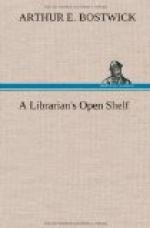When we have once discovered the cause of a malady, we may proceed in two ways to combat it; either we may destroy the cause or we may render the possible victims immune. To put it a little differently, we may eliminate either of the two elements whose conjunction causes the disease. To grow weeds, there must co-exist their seeds and a favourable soil. They may be exterminated either by killing the seeds or sterilising the soil. Either of these methods may be used in dealing with the disease that prevails among readers, or, if you prefer the other metaphor, with the rank vegetation that has choked the fertile soil of their minds, making any legitimate mental crop impossible. We have seen that the conditions favorable to the disease are a lack of interest and a fallacious idea that there is something inherent in the printed page per se that makes its perusal valuable whether the reader is interested or not—somewhat as a charm is supposed to work even when it is in a language that the user does not understand.
We are considering only the form of the disease that affects clubwomen, and this we have diagnosed as programitis—the imposition of a set programme of work—which, as an exciting cause, operates on the mental soil prepared by indifference and fetichism to produce the malady from which so many are now suffering.
I think physicians will generally agree that where the exciting cause can be totally removed that method of dealing with the disease is far more effective than any attempt to secure immunity. I believe that in most cases it is so in the present instance.
In other words, my prescription is the abandonment, in nine cases out of ten, of the set programme, and the substitution of something that is interesting primarily to each individual concerned. This is no new doctrine. Listen to William James:
Any object not interesting in itself may become interesting through becoming associated with an object in which an interest already exists. The two associated objects grow, as it were, together: the interesting portion sheds its quality over the whole; and thus things not interesting in their own right borrow an interest which becomes as real and as strong as that of any natively interesting thing.... If we could recall for a moment our whole individual history, we should see that our professional ideals and the zeal they inspire are due to nothing but the slow accretion of one mental object to another, traceable backward from point to point till we reach the moment when, in the nursery or in the schoolroom, some little story told, some little object shown, some little operation witnessed, brought the first new object and new interest within our ken by associating it with some one of those primitively there. The interest now suffusing the whole system took its rise in that little event, so insignificant to us now as to be entirely forgotten. As the bees in swarming cling to one another in layers till




